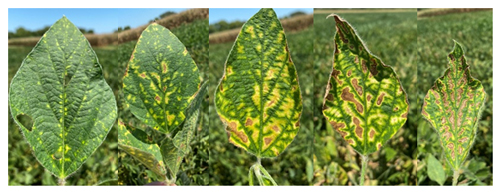We are in search of grower fields with symptomatic Sudden Death Syndrome (SDS) plants for us to sample. Within the past two weeks, Sudden Death Syndrome has been reported in several counties in the eastern and central parts of Kansas.
What is Sudden Death Syndrome?
It is a soil-borne fungal disease caused by Fusarium virguliforme. Infection and colonization begin shortly after planting and the pathogen produces a toxin that causes above-ground symptoms later in the season.
What are the symptoms?
Root symptoms include necrosis and above-ground symptoms include interveinal leaf chlorosis and necrosis (Figure 1). Under the right environmental conditions, these symptoms appear as early as the start of flowering.

Figure 1. Sudden Death Syndrome foliar symptoms.
What are the environmental conditions?
SDS is observed more when planted in cool, wet soils followed by wet conditions at the beginning of flowering, and fields infested with soybean cyst nematode.
What are the management options?
Seed treatment, resistant cultivars, planting date, tillage, and crop rotation.
If you are or know of someone willing to participate, please contact us:
Madison Kessler
K-State Plant Pathology Department
Graduate Student
mkessler@ksu.edu
Rodrigo Onofre
K-State Plant Pathology Department
Assistant Professor
onofre@ksu.edu
785-477-0171